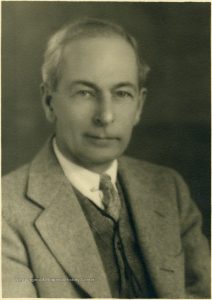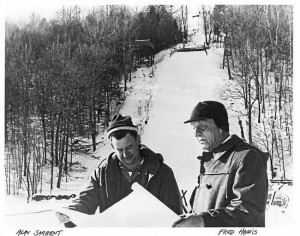I hope everyone had a great Thanksgiving! My wife and I snuck in a couple of runs Thanksgiving morning before heading off for our turkey. Speaking of turkeys, based on the abilities of the folks skiing Thanksgiving morning and where they were stopping (or lying), it would appear that the addition of Hunter Mountain to the Epic family has had an impact.
Well, enough sarcasm.
So who was the first person to make a recorded skiing descent of Mount Mansfield? David “Carving” Carter had the answer that Nathaniel Goodrich was the first to do it and the year was 1914.
 Nathaniel Goodrich was born in New Hampshire. He graduated from Amherst College and then went on to get a degree in Library Science from the New York State Library School. In 1912 he became the Dartmouth College librarian, a post he would hold until 1950!
Nathaniel Goodrich was born in New Hampshire. He graduated from Amherst College and then went on to get a degree in Library Science from the New York State Library School. In 1912 he became the Dartmouth College librarian, a post he would hold until 1950!
Goodrich was a mountaineer who climbed over 75 major peaks in North America and Europe. In the winter he relied on skis more as a way to get up mountains than to ski down. But eventually he became a proficient downhill skier.
However the first descent of Mount Mansfield occurred before he achieved that proficiency. On February 1, 1914, Goodrich on skis and a friend on snowshoes ascended the toll road. After reaching the top, the toll road offered an inviting opportunity to ski back down. Using what Goodrich would later describe as “a Telemark technique learned from books,” he made it down the Toll Road. However to his chagrin, his friend on snowshoes arrived only a couple of minutes behind Goodrich. Goodrich did admit he stopped quite a few times on the way down, some were planned and some were not!
Goodrich would go on to write two books on skiing and be the first editor of the American Ski Annual. In his role as Dartmouth librarian, Goodrich would collect the most comprehensive set of skiing and mountaineering material in the United States. Goodrich was inducted into the U.S. Ski and Snowboard Hall of Fame in 1971.
The Nathaniel Goodrich story is part of the new “Green Mountains, White Gold” exhibit at the Vermont Ski and Snowboard Museum. The exhibit traces the origins of skiing in Vermont. The images and text were provided by the New England Ski Museum and the VTSSM has augmented them with artifacts from its collection.
Vermont’s skiing origins go back before 1914. At that time skiing was what we would now call ski touring. Few people were climbing up just to ski down. Skiing competitions were like running events on skis or ski jumping. The first winter carnival in the United States built around skiing events was in 1909 organized by James “Pops” Taylor at Vermont Academy in Saxton’s River. Dartmouth liked the concept so much they adopted it in 1911. Dartmouth will be celebrating their 110th winter carnival in February 2020.
 In the 1920s ski jumping became extremely popular as a spectator sport. Fred Harris built a ski jump in Brattleboro in 1921 that attracted big name jumpers of the era and drew large crowds. As many as 10,000 people came to see the events. The Harris Ski Jump still hosts major competitions!
In the 1920s ski jumping became extremely popular as a spectator sport. Fred Harris built a ski jump in Brattleboro in 1921 that attracted big name jumpers of the era and drew large crowds. As many as 10,000 people came to see the events. The Harris Ski Jump still hosts major competitions!
In the late 1920s and early 1930s more people became interested in the ability of climbing up to ski down hills. In the Woodstock area this led to the first ski lift in the United States, the rope tow on Gilbert’s Hill. The exhibit contains photos of that original tow and the White Cupboard Inn where the idea for that first lift was conceived.
 There are also some classic photos of the development of skiing on Mount Mansfield. There’s a picture of Mount Mansfield before any lifts, where there is only one visible trail, the Nosedive. There’s also the picture of Nosedive Annie in the first chair of the original single chairlift.
There are also some classic photos of the development of skiing on Mount Mansfield. There’s a picture of Mount Mansfield before any lifts, where there is only one visible trail, the Nosedive. There’s also the picture of Nosedive Annie in the first chair of the original single chairlift.
The “Green Mountains, White Gold” exhibit will have its official opening Friday, December 6th (tomorrow!) As part of the “Traditional Christmas in Stowe,” the opening will be from 6:30-8:30PM and admission is free! In addition to “Green Mountains, White Gold,” another new exhibit is opening. “Surfing Snow” features snowboards designed by JG Gerndt and inspired by Vermont.

Leave a Reply